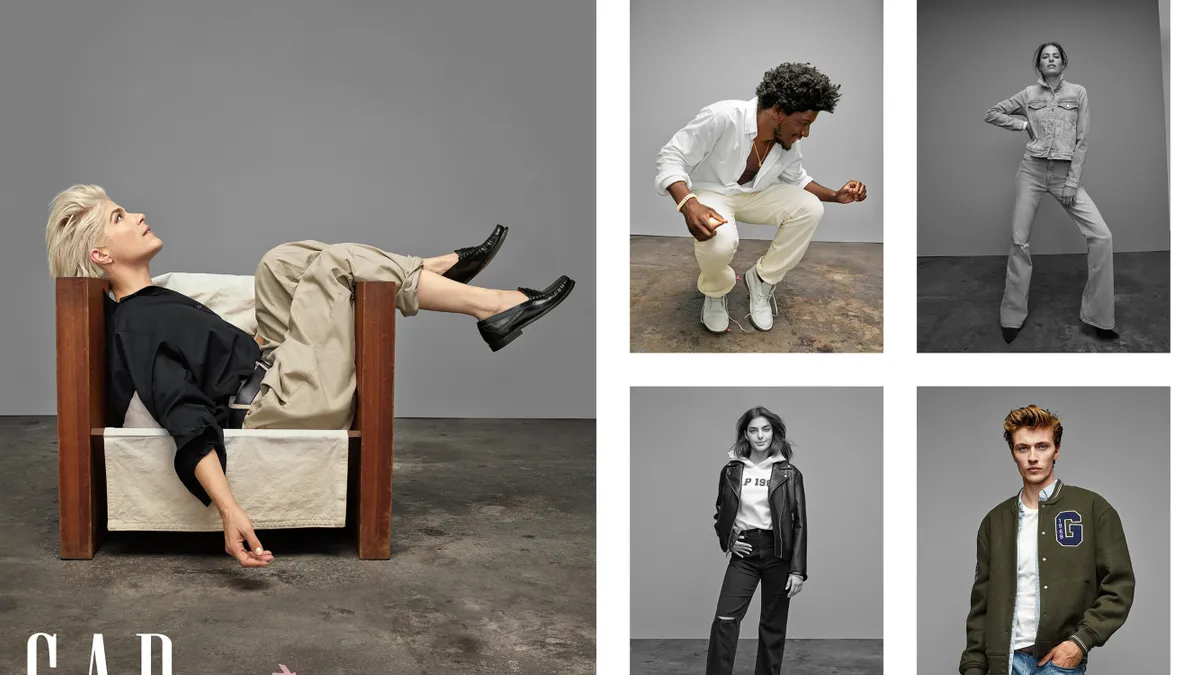Dive Brief:
- Gap is placing culture-shapers center stage for its fall campaign, titled “Icons,” according to a press release. The campaign launched Sept. 6 and will run across digital media, out-of-home and Gap’s brand channels.
- “Icons” enlists those using their platform for change and promotes loose fitting, everyday wear. Chosen for the campaign is actress and New York Times bestselling author Selma Blair, musical artist Labrinth, professional race car driver Toni Breidinger, actor Lucky Blue Smith and model Cameron Russell.
- Also tied to the campaign is an NFT contest, Gap Logo Remix, which invites artists to design a Gap logo for the chance to have it turned into an NFT and placed on a hoodie. The campaign holds consistent to the brand’s years-long inclusivity efforts, with digital elements could help attract younger consumers.
Dive Insight:
Gap’s latest move and overarching message of inclusivity is a common theme for the brand and falls under its “modern American optimism” through line first introduced in 2020. Such similar themes were recently portrayed in its latest Gap Kids campaign and were also clear in last fall’s adult campaign, “Individuals,” which also enlisted a series of diverse personalities using their voice to spur change.
This fall’s “Icons” campaign in many ways mirrors last year’s effort, taking an influential, star-studded approach that could spike interest across a wide range of communities. Campaign materials include playful 15-second spots featuring Labrinth, known by many for his work on HBO’s “Euphoria,” and actress Selma Blair, a known advocate for those battling multiple sclerosis. The personality-showcasing campaign will debut on digital channels, out-of-home and Gap’s brand channels. Gap also invites consumers to use the hashtag #HowYouWearGap on social media.
Meant to promote loose organic cotton denim, high rise ‘70s flare denim and big white shirts, among other items, the campaign also boasts responsibly made fabrics, touching on a growing concern for sustainability as the brand fights fast fashion competitors during a time many are cutting back on spending. However, many will pay the price for responsible manufacturing: 67% of consumers prioritize the use of sustainable materials as they debate their purchase, according to a McKinsey report. Further, 63% of consumers are prioritizing brands who promote their sustainable practices.
Stepping outside of more traditional tactics by the brand, Gap also launched its Gap Logo Remix project that invites artists to design a Gap logo. Customers will have a say in what looks best, voting on three designs that will then become NFTs and be printed on hoodies to be sold on the brand’s website. Gap is also hosting NFT-interested fans on its own Discord server, another ploy to foster a community that could further its access to first-party data as it looks to appeal to niche communities among Gen Z, Gen Alpha and millennials.
Gap has previously dipped its toes in the digital space, having collaborated with artist Brandon Sines, the mastermind behind the cartoon Frank Ape, to create an NFT collection based around Gap’s signature hoodie. In July, the company collaborated with French NFT brand Dogami to create digital pet merchandise. Both collaborations also included a tie-in with an open-source blockchain platform Tezos, known for its emphasis on a low carbon footprint. The brand in May also launched its Club Roblox Boutique, designed to replicate a Gap Teen store.
As economic woes persist, Gap parent company Gap Inc., also parent to Old Navy, Banana Republic and Athleta, reported a dip in revenue during the second quarter, falling 8% compared to the same period last year to $3.86 billion, according to its latest earnings statement. Similarly, Gap fell 10% to $881 million, a decline credited to category mix imbalances, store closures and inflationary pressures.















